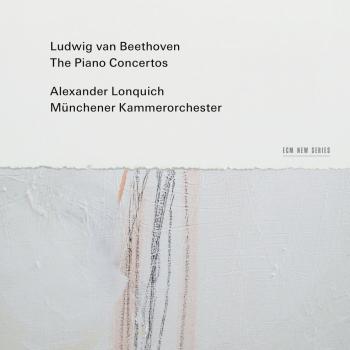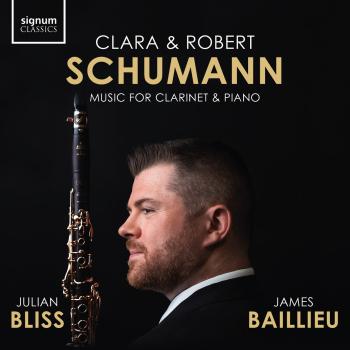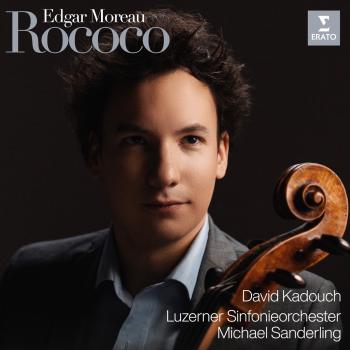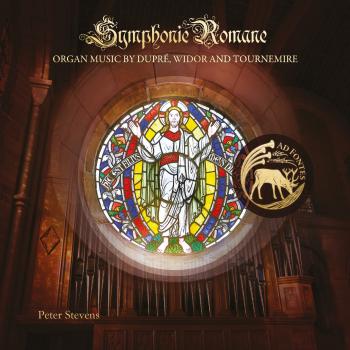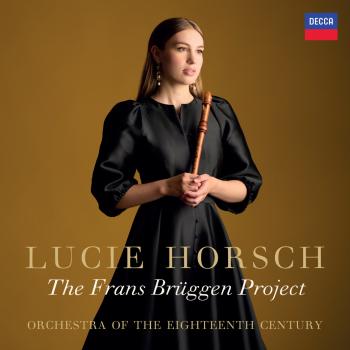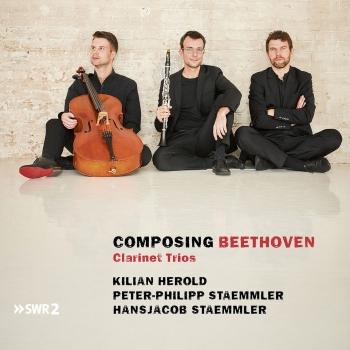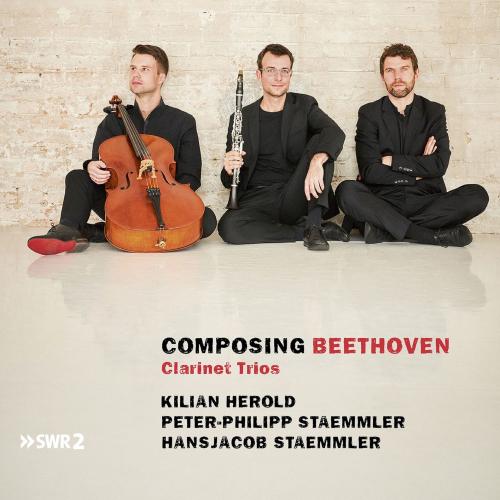
Composing Beethoven Kilian Herold, Peter-Philipp Staemmler & Hansjacob Staemmler
Album info
Album-Release:
2019
HRA-Release:
01.05.2020
Label: Deutsche Grammophon GmbH, Berlin
Genre: Classical
Subgenre: Chamber Music
Artist: Kilian Herold, Peter-Philipp Staemmler & Hansjacob Staemmler
Album including Album cover Booklet (PDF)
I`m sorry!
Dear HIGHRESAUDIO Visitor,
due to territorial constraints and also different releases dates in each country you currently can`t purchase this album. We are updating our release dates twice a week. So, please feel free to check from time-to-time, if the album is available for your country.
We suggest, that you bookmark the album and use our Short List function.
Thank you for your understanding and patience.
Yours sincerely, HIGHRESAUDIO
- Ludwig van Beethoven (1770 - 1827): Trio for Clarinet, Cello and Piano No. 4 in B-Flat Major, Op. 11 "Gassenhauer Trio":
- 1 Trio for Clarinet, Cello and Piano No. 4 in B-Flat Major, Op. 11 "Gassenhauer Trio": I. Allegro con brio 08:49
- 2 Trio for Clarinet, Cello and Piano No. 4 in B-Flat Major, Op. 11 "Gassenhauer Trio": II. Adagio 04:53
- 3 Trio for Clarinet, Cello and Piano No. 4 in B-Flat Major, Op. 11 "Gassenhauer Trio": III. Thema "Pria ch'io l'impegno". Allegretto - Var. I-IX 06:42
- Bagatelles, Op. 119:
- 4 Bagatelles, Op. 119: No. 1. Allegretto (Arr. for Clarinet, Cello and Piano) 02:11
- 5 Bagatelles, Op. 119: No. 2. Andante con moto (Arr. for Clarinet, Cello and Piano) 00:54
- 6 Bagatelles, Op. 119: No. 3. à l'Allemande (Arr. for Clarinet, Cello and Piano) 01:38
- 7 Bagatelles, Op. 119: No. 4. Andante cantabile (Arr. for Clarinet, Cello and Piano) 01:51
- 8 Bagatelles, Op. 119: No. 5. Risoluto (Arr. for Clarinet, Cello and Piano) 00:58
- 9 Bagatelles, Op. 119: No. 6. Andante - Allegretto (Arr. for Clarinet, Cello and Piano) 01:43
- 10 Bagatelles, Op. 119: No. 7. No title (Arr. for Clarinet, Cello and Piano) 01:18
- 11 Bagatelles, Op. 119: No. 8. Moderato cantabile (Arr. for Clarinet, Cello and Piano) 01:30
- 12 Bagatelles, Op. 119: No. 9. Vivace moderato (Arr. for Clarinet, Cello and Piano) 00:37
- 13 Bagatelles, Op. 119: No. 10. Allegramente (Arr. for Clarinet, Cello and Piano) 00:13
- 14 Bagatelles, Op. 119: No. 11. Andante ma non troppo (Arr. for Clarinet, Cello and Piano) 01:54
- Trio for Piano, Clarinet and Cello in E-Flat Major, Op. 38:
- 15 Trio for Piano, Clarinet and Cello in E-Flat Major, Op. 38: I. Adagio - Allegretto con brio 09:33
- 16 Trio for Piano, Clarinet and Cello in E-Flat Major, Op. 38: II. Adagio cantabile 07:30
- 17 Trio for Piano, Clarinet and Cello in E-Flat Major, Op. 38: III. Tempo di Menuetto 03:57
- 18 Trio for Piano, Clarinet and Cello in E-Flat Major, Op. 38: IV. Thema. Andante con Variazioni 07:21
- 19 Trio for Piano, Clarinet and Cello in E-Flat Major, Op. 38: V. Scherzo. Allegro molto e vivace 03:36
- 20 Trio for Piano, Clarinet and Cello in E-Flat Major, Op. 38: VI. Andante con moto alla marcia - Presto 07:35
Info for Composing Beethoven
Composers of all epochs have repeatedly arranged and reworked both their own and other people's works - sometimes these are simple arrangements for sales reasons, but often they are evidence of creative reflection, an interpretative examination of other people's or their own works. With his famous Gassenhauer Trio op. 11, the young Beethoven pulls out all the stops of his ability to demonstrate, by means of an almost primitive, in any case catchy opera melody, the diversity of such a model, while not lacking in humour.
Later he revised his famous, masterly Septet op. 20 to a new work in trio instrumentation, his Trio op.38.
With his "Transcompositions", the renowned composer and university professor Johannes Schöllhorn deals with great predecessors in a similarly creative, very contemporary way. For "Composing Beethoven" he has transformed the late Piano Bagatelles op.119 into an idiosyncratic trio version that casts new light on well-known compositions.
No one knows who first gave Beethoven’s Trio Op. 11 the nickname Gassenhauer (“street song”). Neither do we know if the name was kindly intended or derogatory, chosen to boost sales or perhaps meant ironically (Heinrich Heine, for instance, would later satirize the omnipresence of a tune, sung everywhere, from Weber’s opera chorus “Wir winden dir den Jungfernkranz”).
The catchy tune in Beethoven’s final movement with variations was the vocal trio “Pria ch‘io l‘impegno” (“Before I go to work”) from the comic opera L‘Amor marinaro (The Sailor’s Love), composed in 1797 by Joseph Weigl, who was a godchild of Haydn and had been pupil of Antonio Salieri.
The aria enjoyed widespread, long-term popularity: more than 30 years after the opera’s première, Paganini still delighted Vienna audiences with variations on the same tune. Beethoven wrote his instrumental trio only half a year after the première, probably fulfilling a commission by clarinetist Joseph Bähr, who is said to have asked for variations on that theme.
We cannot know whether Beethoven even liked the theme or not…….The most extended item on the program was a work with a relatively reduced lineup of musicians, a sort of reduced court orchestra: the “Septet on 4 string and 3 wind instruments, most humbly and obediently dedicated to Her Majesty the Empress, and played by Sirs Schuppanzigh, Schreiber, Schindlecker, Bär, Nickel, Matauschek, and Dietzel” …… which remained Beethoven’s most performed work in the course of his lifetime. Beethoven himself arranged this work with an own Opus number for Clarinet, Cello and Piano around 1802 for the Publisher Breitkopf & Härtel….
When clarinetist Kilian Herold asked composer Johannes Schöllhorn to arrange a Beethoven work for trio, Schöllhorn thought of the Bagatelles Op. 119. The idea was to add a final level to a three-level concept, Composing Beethoven, consisting in an original work by Beethoven, then one of Beethoven’s arrangements of his own works, and, finally, a work by Beethoven arranged by a 21st-century composer. Schöllhorn, already wellexperienced in creative approaches to music of the past, deconstructs the original piano texture here in such a way that the resulting sound is not too lean, but opens up new areas of freedom for the pianist’s new partners.
He has conceived a light, airy trio texture brimming with discreet punch lines, interruptions, disruptions, unexpected connections, and cello sonorities ranging from sul tasto to col legno battuto, resulting in a fond, respectful homage to Beethoven.
Kilian Herold, clarinet
Peter-Philipp Staemmler, cello
Hansjacob Staemmer, piano
Kilian Herold
belongs to Germany's most sought after clarinet players. After studying in Berlin, Chicago and Hannover, he won the audition for Principal Clarinet of the Deutsche Kammerphilharmonie Bremen in 2004, at the young age of 23. In addition, he became in 2011 the new Principal Clarinet of the SWR Radio Symphony Orchestra of Baden-Baden and Freiburg.
Ever since then, his fine playing has been featured on many CD and DVD recordings made by that renowned chamber orchestra (for instance , the Beethoven and Schumann symphony cycles with Paavo Järvi), and also in their live performances in Germany and abroad.
As solo clarinetist he is often invited to play with some of the mostrenowned orchestras including the Berlin Philharmonic, the Bavaria Radio Symphony Orchestra, the Dresden Staatskapelle, the WDR Symphony Orchestra, in collaboration with conductors such as Paavo Järvi, Daniel Harding, Theodor Currentzis, Christoph Eschenbach, Herbert Blomstedt, Francois Xavier Roth and Valerie Gergiev. His impassioned chamber music and solo performances have thrilled festival audiences at Rheingau Music Festival, Schleswig-Holstein and the Baden-Baden International Brahms Festival, along with further recitals all over Europe, in South America, India and Japan.
Kilian Herold has appeared as soloist with orchestras like the Deutsche Kammerphilharmonie Bremen, SWR Symphony Orchestra and Istanbul Devlet Symphony Orchestra playing the clarinet concertos by Mozart, Weber and Nielsen.
In autumn 2012 his new CD with works by Brahms and Comtemporaries recorded with pianist Amir Katz was released by Avi-Music. In 2017 a new CD project with works by Hungarian composer Matyas Seiber together with German soprano Sarah Maria Sun was released.
In April 2016 Kilian Herold was appointed the new clarinet professor at the Musikhochschule Freiburg / Freiburg University of Music.
He is teaching regularly at masterclasses and festivals. In Staufen, in the south of Germany, Kilian Herold has started his own successful clarinet festival "ClariMondo".
Booklet for Composing Beethoven


